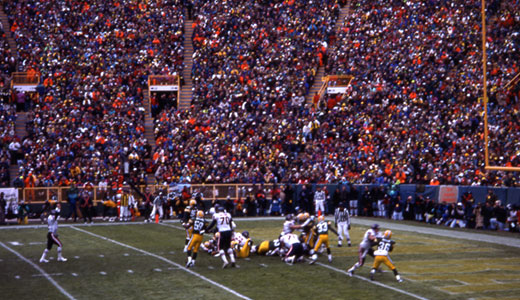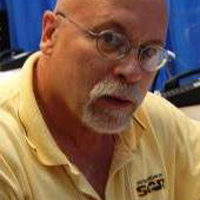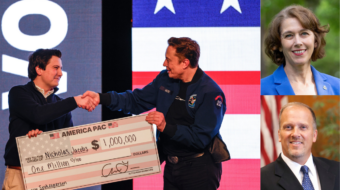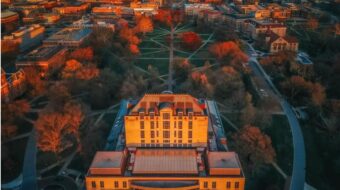
COLUMBUS, Ohio – The final gun sounded on last week’s Super Bowl and Green Bay had won its 14th National Football League championship, the most of any NFL franchise. I’m sure that some folks sitting in front of their TVs were wondering, “Why does the little working -class town of Green Bay have an NFL franchise?” For those interested in the history of our nation’s working class, there is an interesting story behind that question.
Tough game played by tough guys
The NFL as we’ve come to know it would not have been recognizable among the early warriors that played the game. Beginning in 1919, but not made an official league until the following year, the NFL truly was a working class game. Based in the Ohio Valley area, most of the small, tough working class steel and coal towns along the Ohio River had NFL franchises. Teams were made up of hard-bitten former, present or future coal miners, steelworkers, dockworkers or railroad men. The late, great Cleveland Browns kicker Lou Groza, who hailed from Steubenville, on the Ohio River, used to say, referring to the football field, then to the local steel mill and coal mine tipples, “If you didn’t make it there [football field], then you’d be going right back over there!”
The pro football played in those days bore as little resemblance to the East Coast college sport then played primarily by well-to-do college students, as it does to the fast, highly financed, televised game of today. Players of those days could not imagine the safety rules, well-developed equipment or high wages paid to players today or the massive amounts generated for present-day team owners. Players of those days played for survival, a little extra spending money, and (oh yeah) the love of the game! They generally had mill jobs or other jobs on the side.
The six Nesser brothers who played for the Columbus Panhandles during the 1920s were no exception. The Nessers were all rail workers. Railyard workers told stories of the Nessers leaping off the train to play hard-fought, bloody practice games on the gravel by the tracks, just to “toughen themselves up.”
Green Bay takes over the Packers
While Chicago, Cleveland and Pittsburgh had early franchises, so did towns like Decator, Dayton, Portsmouth, Ironton, Duluth, Hammond, Muncie, Newark, Orange and Toledo. Frigid little Green Bay, Wisconsin, a packinghouse and fishing center on Lake Michigan, also had a franchise. Green Bay’s was an original franchise in the NFL, organized by Curly Lambeau in 1919.
Lambeau was an intense, resilient young football star from Green Bay who’d briefly attended Notre Dame. His family were mill workers, however, and he could not afford the high tuition. Returning to a job at Indian Packing House, Green Bay’s main industry, Lambeau went to work organizing a football team. The Packers were born, mostly manned by and named after, the local packinghouse workers. It is here that this story gets quite interesting.
In 1920, and going forward, NFL team meetings were organized and held in Canton, Ohio, home of the present-day NFL Hall of Fame. Lambeau had little money, but he badly wanted to get to Canton. After trying to float loans from friends, family and local banks, all unsuccessfully, Lambeau worked out a deal to sell his share of the Green Bay Packers to the city of Green Bay, for the paltry sum of $200! From then on, Green Bay’s Packers fans became the only ones able to rightfully refer to the team as “OUR Packers!” Reportedly many of the citizens of Green Bay have the early team shares that they purchased framed and proudly displayed on their walls.
Lambeau led the Packers to six championships, in 1929, ’30, ’31, ’36, ’39 and ’40. When the new stadium was built in 1958, it bore Curly Lambeau’s name. It was here that Vince Lombardi’s publicly owned Packers won six titles during the 1960s, including the first two Super Bowls.
A players’ league
The early NFL of Lambeau’s time was what we’d call a “players’ league,” meaning that it was run by and for the players. Many teams had “player-coaches” who actually played for the team as well as coached them.
One of the best of those early player-coached teams was the Akron Pros. The Pros had been an African American semi-pro industrial team, founded in 1908, but shifted to paying its players, becoming a “pro” team in 1919. They were coached by Fritz Pollard, one of the greatest of the early running backs, finally elected to the NFL Hall of Fame 20 years after his death in 1965. Pollard was fast and elusive and, at only 5’8, 160 pounds, one of the toughest players ever to wear a uniform.
Also part of that team was the great singer, actor, activist and College Football Hall of Fame inductee Paul Robeson. After tearing the college league up as a defensive end for Rutgers University, Robeson joined the Akron Pros of the new NFL, helping them to undefeated seasons in 1919 abd ’20 and the first championships of the NFL. Robeson also played for Milwaukee in ’21, before launching into the rest his life, as a singer, actor and fighter for political, economic and social justice, for which he is so well known.
As a players’ league, the early NFL did not have any color line. Fritz Pollard opened the NFL’s first season as one of three African American coaches in the league. The tremendous Native American athlete Jim Thorpe was the NFL’s first president, while also coaching and playing for the Native American football team in Carlisle, Pennsylvania.
Jim Crow makes an appearance
All that changed, like most of the nation, when the Depression hit. For the young National Football League, it meant unmet payrolls, empty stadiums and teams going bankrupt. This is when the “new” NFL came to be, with big money from big cities. These new owners bought up the NFL franchises and moved almost all of them to big city markets. No more would pro football be the game played by tough workers of all creeds and colors. These new owners, like their fellow owners in pro baseball, immediately established a color line for the NFL.
And no longer would pro football be a game played in those small working class towns. But there was one lonely exception. Up in the frozen tundra of Green Bay, the mill workers, fishermen and regular folks still had their shares of the team. They, not big money out-of-town financiers, were the owners of the Green Bay Packers. The new owners had to swallow this bitter pill. They could not move the Packers!
The new NFL owners wrote into the league’s by-laws that they would no longer allow any publicly owned franchise to be part of the league. But the publicly owned Packers would go on to win 14 championships (so far), most of any NFL team. They’ve done that playing football at Lambeau Field, an open air field in the coldest climate of any NFL city. There would never be, however, an empty seat there!
Browns break the color line
The disgusting color line remained in place, tainting the NFL, until the son of socialists in Ohio founded a new team in Cleveland. Paul Brown, whose folks had been long-time supporters of Ohio’s Socialist Party, set up the Cleveland Browns after World War II. The color line was not an issue for him. Bringing to the NFL a new, high-powered passing attack and bruising defense, Brown viewed the color line much the way he viewed opposing defenses. It was there to be torn down!
Brown helped found a new professional football league, the All American Football Conference (AAFC). Cleveland won the AAFC every year. Playing in starring roles for the Browns were African American stars Marion Motley (fullback), Bill Willis (defensive end), Horace Gillom (punter), and Bill Ford (defensive lineman), all later inducted into the NFL Hall of Fame.
One interesting story of the early Browns concerned the Miami Seahawks team in the AAFC. Touted by Seahawks owners as being made up of all “good healthy white southern boys,” they adamantly refused the Browns’ request that all their players be treated the same when they came to Miami to play. The Browns notified the Seahawks before the 1946 season that they would never travel to Miami if their African American players were to be treated unfairly. Miami then had to play all its games against the Browns in Cleveland. The Browns never lost to the Seahawks, and those games were never close.
The Browns are also one of the NFL’s “storied franchises.” Cleveland has won eight championships, AAFC & NFL, third amongst all NFL cities. Unfortunately for Browns fans like me, however, none since 1964, when the great Jim Brown was running the ball for them!
Influence of the only publicly owned team
Part of being a Browns fan is having a close relationship with disappointment and misery. In Cleveland we even have names for our losses: Red Right 88 (1980), The Drive (’87), The Fumble (’87), but, of course nothing comes close to The Move (1999) when owner Art Modell stole our team and moved it to Baltimore.
The people of Baltimore have certainly also had their own close association with misery because of their football team.
Remember that horrible Miami team, with the racist owners, that I mentioned above? It folded after just one year and moved to, you guessed it, Baltimore. By 1953, that team had also folded, this time to be replaced with what is probably the worst team in NFL history, the former Dallas Texans. The new Baltimore Colts went winless, but it was so bad that it became a joke. They couldn’t pay their players and didn’t even have a stadium to play in. In those days players got jobs during the off-season. Some players there missed games because the jobs they now had paid more.
The 1960s saw the arrival of John Unitas, one of the greatest quarterbacks in the game’s history, after he was cut by the then-hapless Pittsburgh Steelers. Unitas led the Colts to two championships. Baltimore finally had real football respectability and a team to love. But that was before the corporate financier Robert Irsay took over ownership of the team. Irsay loaded the Colts into moving vans in the middle of the night in 1984 and moved them to Indianapolis, breaking the hearts of every true Baltimorian!
Which brings us to Art Modell’s theft of the Browns, moving them to Baltimore 15 years later, where they became the Ravens.
Cleveland got a new, expansion franchise keeping the Browns name. However, few know how or why that came about.
It was not a magnanimous act by the NFL. In fact, the rulers of the NFL had absolutely no intention to have anything in Cleveland. That is, before the Cleveland and Lorain labor federations passed resolutions calling for use of eminent domain laws to “take the Browns away from corporate control and put the city of Cleveland in charge of the Browns, like the Packers are in Green Bay!”
The Cleveland City Council followed suit and local radio stations began to make that call their own. The movement culminated at the last home game of the year against the publicly owned Green Bay Packers. An estimated 30-40,000 marched to the stadium demanding a new franchise. An issue of this newspaper’s predecessor, People’s Weekly World, decked out in brown and orange, the Browns colors, was handed out at Municipal Stadium, itself a publicly built and owned facility. Soon after that, Cleveland Mayor Michael White announced new meetings with the NFL to bring an expansion team to town.
While the Browns haven’t been very good since, I’ve never forgotten how quick the big money folks were to jump as soon as the issue of public ownership was placed on the table. Also memorable was the fact that so many workers, many of them steelworkers who’d recently lost mill jobs, were ready to go out and demand public ownership for “their” Browns, when they never quite got that to point in regard to their mills. It really shows what an important role culture, in whatever form, plays in our lives.
I’d like to close by remembering the most minor “uproar” that took place in Green Bay a few years ago. Those management types that were in charge of Lambeau Stadium were concerned, upset! “We MUST have a new stadium,” they cried. What they could not cry was the rest of that statement, which has become so familiar to fans of all sports in our society: “… or we’ll move the team!”
Nope, the grandsons and granddaughters of those mill workers who bought those Green Bay Packer shares 91 years ago had their say! I’m not sure who officially carried the message back, but it got there clean and clear: “Nope, we like Lambeau! Revitalize it and shut up!” And that’s what happened!
Stuff like that is easy when you’re the owner!
Photo: Packers versus Bears in Lambeau Field, 1995. DavidWilson1949 CC 2.0











